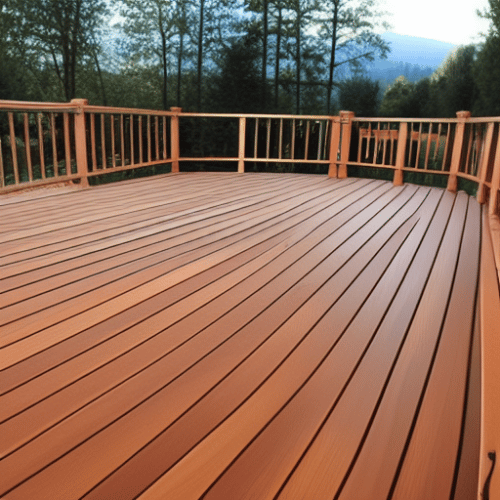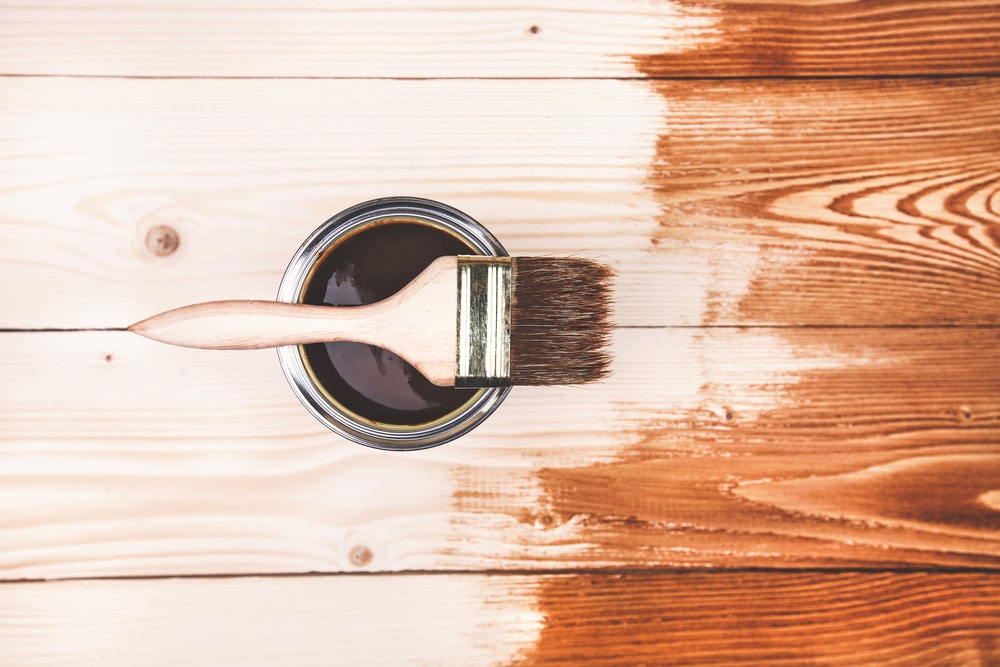Last Updated on
Are you wondering when the most appropriate time is to oil your decking? Then you’ve come to the right place.
Decking oil preserves your wooden deck and gives it a natural and attractive finish. While other products, such as decking stain and decking paint, can help preserve your new or old deck, decking oil is excellent at maintaining the natural grain’s visibility and protecting the wood from sun damage.
It also preserves the natural colour of the deck, keeping wood nourished. To get superb results, you have to apply decking oil to a wooden surface at the right time.
In this article, we will show you when to oil new decking so that you can get your deck maintenance right in the first round.
The Ideal Time to Oil New Deck
Weathering and Timing
If you have installed a new timber decking board in your home, many manufacturers recommend that you let it weather naturally for about 5-6 weeks before you oil it with a new decking treatment. Weathering is the process of exposing bare wood to different moderate weather conditions such as sunlight and wind. However, do not expose the surface to extra harsh conditions, as they may cause wood rot or create small cracks.
You want to let it weather to make some of the preservatives and chemicals on the pre-treated wooden deck fade, making it easier for you to oil your deck.
While the surface of new timber decking boards might not be treated completely, some may have a wood preservative that might give you a hard time as you are oiling your deck. Such chemicals can reduce the adhesion of the decking oil to the wooden surface.
Once the surface of your decking boards is weathered, sand it down to get an even surface. It helps you remove the grain raise effect that might make a wooden surface look uneven after applying decking oil.
Also, make sure that the deck is completely dry before you oil it. If the surface is not completely dry, the decking treatment might not be quite effective in protecting the garden decking from harsh weather conditions. It is also why it’s a good idea to treat the timber on sunny days so that it can dry off in a short time.
Oil Decking Results
In most instances, two coats of clear oil should be applied to preserve and protect the wood grain structure. Further coats may be used if the oil is not enough. The best decking oil can improve the durability of your deck. Once you apply oil on a deck, you have to keep on reapplying oil after a certain period of time. On old decks that haven’t had much care, you may also have to perform a restoration project if the surface is too weathered.
While decking oil boosts the colour of the wood grain, most oils do not have a deep-coloured finish. However, coloured oil can make a deck look superb while preserving its natural grain.
If you’re looking for a more drastic colour change, you may want to have a look at decking stains. Decking stains have richer colours than deck oils and are available in various colours to make a deck look more attractive. However, keep in mind that decking stains protect timber surfaces differently and may not be as effective, as the stain often does not penetrate the wood’s surface as much.
Types of Timber for Decking Boards
Here are the different types of timbers that can be used to make your decking:
Merbau – Due to its durability and strength, this type of wood is used to make different types of decking boards. It is a popular choice; however, it comes with various tannins that can leach and stain some of the close objects.
Due to this, it’s a good idea to let Merbau boards weather to let the tannins leach out before applying the decking treatment. As a general rule of thumb, you can oil a deck made from Merbau after six weeks.
Ironbark – This type of wood has a very high density and can carry heavy loads. Not to mention, it is resistant to termites and rot. Due to this, Ironbark is mainly used in the construction of pool decks. Plus, it has a rich brown colour that is quite elegant.
Since Ironbark has a heavy density, it can be difficult to move, so you may not want to shift it once it’s in place. A fresh coat of deck oil can be applied on an Ironbark deck after five weeks.
Pine – This type of wood is widely available and has a high-quality grain structure that can make your deck look superb. Not to mention, it can easily absorb treatments. Oiling decking boards made from Pine can be pretty easy.
Things to Do Before You Apply Oil on Your New Deck
Once the decking board weathers completely, you have to prepare it. Here are some of the things that you can do to prepare your deck:
Cleaning Your Deck

Since most decks have a lot of foot traffic, cleaning your decking board helps you get rid of the grime, green staining and dirt particles that might be on the deck’s surface. Such particles might make it quite hard for you to oil the decking board and, if your decking is not properly cleaned, you may also end up with an uneven finish.
While you can use different products to clean the surface, a decking cleaner or sugar soap are often considered the most appropriate products. This is because decking cleaners are quite effective in getting rid of dirt particles, and while a non-decking cleaning solution might also do the job, it may contain chemicals that might be too harsh to your timber deck.
If you’re unsure, check your deck’s care instructions or contact your timber supplier to get more information on the cleaning product you should use.
After you’ve applied the decking cleaner and some warm water on your timber deck, use a stiff broom to scrub off some of the dirt particles that might be on its surface. Depending on how often you have done this, you may need to put in some elbow grease, too. Once done, rinse the surface with some clean water.
Additionally, you can wash the surface with a pressure washer to get good results. It is not a time-consuming cleaning technique. However, you need to ensure that the pressure washer settings aren’t set to a high setting. Less pressure is more effective and doesn’t affect the deck, as strong jet washing can be destructive if it’s not done in the right way.
Check the Weather Forecast
Once you apply oil on a wooden surface, you have to let the first coat dry off completely for about two days in warm and dry weather. If the decking oil doesn’t dry off, the surface will have a sticky finish. Check the forecast and select the most appropriate week to oil your new deck.
If applying a second coat of deck oils, you will have to plan in another two to three days to let it dry completely.
Also, make sure that no one walks through the deck once you finish oiling it. If this happens, the decking oil won’t adhere completely to the wooden surface, and you will end up with an uneven finish.
Look For the Right Type of Decking Oils
While most deck oils perform the same function, different decking oils can be applied to a new timber deck. The two main types of oils that can be applied on a wooden deck are non-water based and water-based. Here again, you should double-check what type would best suit your softwood or hardwood decking.
Benefits of Decking Oils
Natural Finish
Decking oil can penetrate deep into your wooden deck and enhance the natural colours of the wooden grains.
Moreover, decking oil penetrates a wooden decking and nourishes the grain.
Waterproof
Decking oil nourishes the wood grain and protects it from the side effects of water, such as rotting. Once you oil your decking, water will not seep/penetrate the wooden surface.
UV Protection
UV rays from the sun can damage wooden grains, making the boards vulnerable to warping, cupping, sloughing and cracking. Deck oils can also protect the wood from the harsh effects of sun rays.
Long-Lasting Preservative Effect
Once it is applied on a specific surface, decking oil can protect a wooden surface for a long time.
Protects From Algae and Mould
Mould and algae species always grow in damp areas. Since decking oil is resistant to water, it keeps your deck dry and free from water. However, if water is poured on your deck, it will form some beads that can quickly run off the surface, and then drain into the ground.
While rainwater might flow through the surface of decking wood, it can’t penetrate the interior grains of the wood. Due to this, decking oil inhibits the growth of mould and algae on your deck.
Oil Your Deck at the Right Time
Understanding when to oil new decking is essential to get the best result. If you have installed a new deck with new timber panels, allow the timber surface to weather for about five weeks to six weeks before you oil the whole deck. The weathering process breaks down different chemicals and prepares the surface for oiling. While the weathering stage is quite crucial, the deck should not weather for long periods.
Clean your deck with the appropriate soap or chemical solution, let it dry completely and then apply the decking in several coats or as needed. And there you have it, a beautifully protected timber deck.
Ian loves everything that revolves around the home improvement niche. He loves trying out new home appliances. He has also handled a lot of equipment and has a lot of insight. Plus, he’s worked on various home improvement projects that became a success.
If Ian isn’t busy working on his latest project, you can find him reading up about another one!



